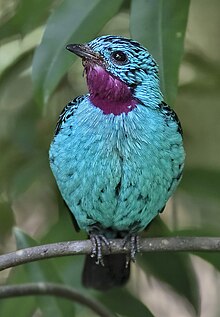Cotinga
| Cotingas | |
|---|---|

| |
| Spangled cotinga (Cotinga cayana) | |
| Scientific classification | |
| Domain: | Eukaryota |
| Kingdom: | Animalia |
| Phylum: | Chordata |
| Class: | Aves |
| Order: | Passeriformes |
| Parvorder: | Tyrannida
|
| Family: | Cotingidae Bonaparte, 1849 |
| Genera | |
|
Many, see text | |

| |
| Geographical range of the cotingas. | |
The cotingas are a large family, Cotingidae, of
Description
Cotingas vary widely in social structure. There is a roughly 50/50 divide in the family between species with biparental care, and those in which the males play no part in raising the young.[3] The purple-throated fruitcrow lives in mixed-sex groups in which one female lays an egg and the others help provide insects to the chick.[4]
In cotinga species where only the females care for the eggs and young, the males have striking courtship displays, often grouped together in
The females of both lekking and biparental species are duller than the males.
Breeding
Nests range from tiny to very large. Many species lay a single egg in a nest so flimsy that the egg can be seen from underneath. This may make the nests hard for predators to find. Fruiteaters build more solid cup nests, and the cocks-of-the-rock attach their mud nests to cliffs.[4] The nests may be open cups or little platforms with loosely woven plant material, usually placed in a tree. The clutches comprise one to four eggs. Incubation typically takes 15–28 days. Fledging usually occurs at 28–33 days.
Habitat
Deserts, open woodlands, coastal mangroves, and humid tropical forests comprise their habitats. Cotingas face very serious threats from the loss of their habitats.[5]
Taxonomy and systematics
The family Cotingidae was introduced by French naturalist
A 2014
| Cotingidae |
| ||||||||||||||||||||||||||||||||||||||||||||||||||||||||||||||||||||||||||||||||||||||||||||||||||||||||||||||||||
The genus Tijuca was found to be embedded in Lipaugus, a position that was confirmed by a more detailed 2020 study.[10]
| Image | Genus | Living species |
|---|---|---|
 |
Ampelioides Verreaux, 1867 |
|
 |
Pipreola Swainson, 1838 |
|
 |
Snowornis Prum, 2001 |
|
 |
Carpornis G.R. Gray, 1846 |
|
 |
Rupicola Brisson, 1760 |
|
 |
Phoenicircus Swainson, 1832 |
|
 |
Zaratornis Koepcke, 1954 |
|
 |
Phytotoma Molina, 1782 |
|
 |
Phibalura Vieillot, 1816 |
|
 |
Doliornis Taczanowski, 1874 |
|
 |
Ampelion Tschudi, 1845 |
|
Haematoderus Bonaparte, 1854 |
| |
 |
Querula Vieillot, 1816 |
|
 |
Pyroderus G.R. Gray, 1840 |
|
 |
Cephalopterus E. Geoffroy Saint-Hilaire, 1809 |
|
 |
Perissocephalus Oberholser, 1899 |
|
 |
Lipaugus F. Boie, 1828 |
|
 |
Procnias Illiger, 1811 |
|
 |
Cotinga Brisson, 1760 |
|
 |
Porphyrolaema Bonaparte, 1854 |
|
 |
Conioptilon Lowery & O'Neill, 1966 |
|
 |
Gymnoderus E. Geoffroy Saint-Hilaire, 1809 |
|
 |
Xipholena Gloger, 1841 |
|
 |
Carpodectes Salvin, 1865 |
|
A number of species previously placed in this family are now placed in the family
References
- S2CID 243289215. Retrieved 30 June 2018.
- S2CID 216264434. Retrieved 30 June 2018.
- PMID 16777726. Supplementary Material.
- ^ ISBN 1-55297-777-3.
- ^ Complete Birds of the World. National Geographic. p. 200.
- hdl:2246/830.
- Rasmussen, Pamela, eds. (July 2021). "Cotingas, manakins, tityras, becards". IOC World Bird List Version 11.2. International Ornithologists' Union. Retrieved 7 December 2021.
- PMID 25234241.
- .
- S2CID 212568712.
- ^ Remsen, J. V. Jr., C. D. Cadena, A. Jaramillo, M. Nores, J. F. Pacheco, M. B. Robbins, T. S. Schulenberg, F. G. Stiles, D. F. Stotz, & K. J. Zimmer. 2007. A classification of the bird species of South America. Archived March 2, 2009, at the Wayback Machine American Ornithologists' Union. Accessed 12 December 2007.
Further reading
- Snow, D.W.(1976). "The relationship between climate and annual cycles in the Cotingidae." Ibis 118(3):366-401
- Snow, D.W. (1982). The Cotingas: Bellbirds, Umbrella birds and their allies. British Museum Press. ISBN 0-19-858511-X
External links
- Cotinga videos on the Internet Bird Collection
